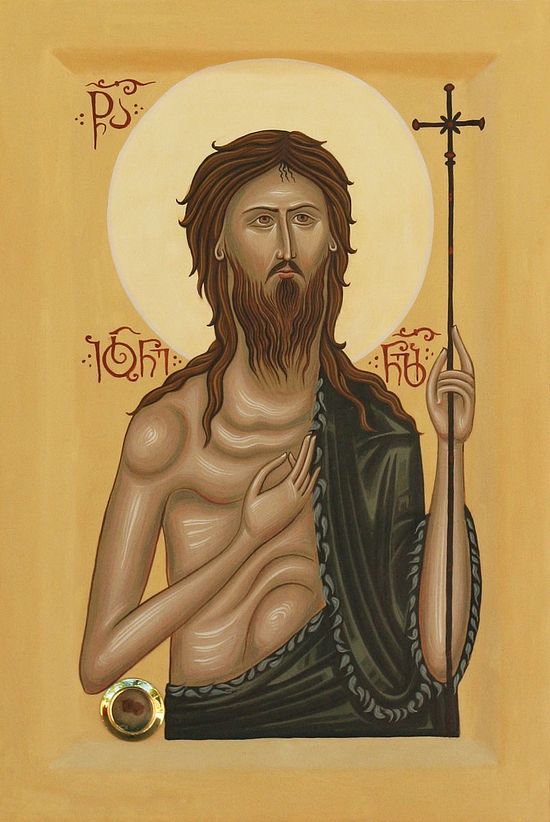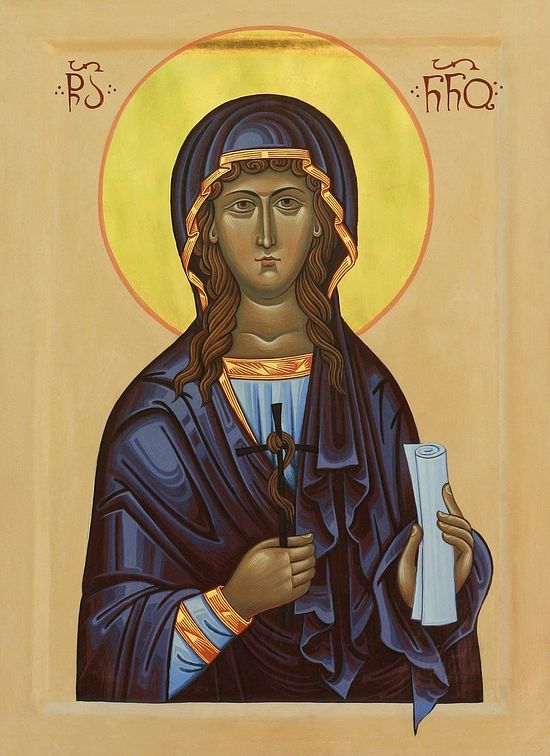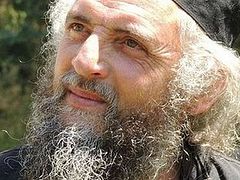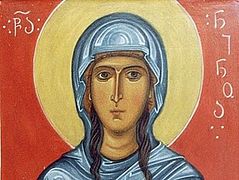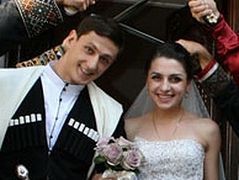Our ever-memorable spiritual father and mentor, Archimandrite Lazarus (born Michael Petrovich Abashidze-Desimon), was born on July 23, 1959, in the town of Gagra in Abkhazia, one of the most beautiful corners of the Caucasus. He graduated from the Russian school of Gagra and studied architecture at one of Moscow institutes. According to the future archimandrite, he had a vague feeling of dissatisfaction from his childhood.
As a student of an institute of higher education in Moscow, Michael Abashidze became distrustful of both the existing regime and the general atmosphere of falsehood and hypocrisy in the world, which stirred up his protest. Since his family was not religious, Michael was still not baptized. His inner dissatisfaction and protest caused him to join the hippie youth movement.
Several years later he found a copy of the Bible and the Orthodox Catechism in his friend’s house. It left an indelible impression on him, the chapter from the Book of Isaiah about the Passion of Christ in particular. From that moment he took a profound interest in Orthodoxy and wanted to comprehend its essence.
On March 11, 1984, the feast of the Triumph of Orthodoxy, as a result of a conscious decision and after a thorough preparation, he was baptized at the age of twenty-four at the Church of the Holy Prophet Elias in Obidenny Lane in Moscow. The priest who baptized Michael asked him about his plans, and the newly-baptized young man said that he intended to stay at a monastery for a while. “A monastery is a good idea,” the priest answered.
Before his Baptism, Michael had been interested in the hermits who lived in Sukhumi near Lake Amtkell. Earlier he used to visit this lake where he saw a handful of empty cells. Shortly before his Baptism the future ascetic had learned about the active monastery of Betania (meaning “the house of poverty”) near Tbilisi, where three monks lived. He resolved to go there for monastic training and then to retreat to the desert of Sukhumi.
On March 20, 1984, Michael left for Betania Monastery, where he stayed until 1997. Over the period of his novitiate he was noted for his discipline and fear of God, zeal in performing obediences, and love of prayer. The first book that he read there was The Way of a Pilgrim: Candid Tales of a Wanderer to His Spiritual Father.
On the feast of the Annunciation, 1986, the monastery’s father-superior Archimandrite John (Sheklashvili) tonsured Novice Michael a monk and gave him the name Lazarus. On Lazarus Saturday the same year His Holiness and Beatitude Catholicos-Patriarch Ilia II of All Georgia ordained him a hierodeacon at the Zion Patriarchal Cathedral, and on the feast of the Holy Spirit he ordained him a hieromonk.
From 1987 till January 14, 1997, Fr. Lazarus was the abbot of Betania Monastery. In spring of 1991, Catholicos-Patriarch Ilia II of All Georgia elevated him to the rank of archimandrite.
Fr. Lazarus was the first to revive the Georgian icon-painting tradition in Georgia. He painted many well-known icons—for example, from the iconostasis at Svetitskhoveli Cathedral, an icon of the Three Holy Hierarchs at Zion Cathedral, of Greatmartyr George, Apostle Thomas, a large cross at Zion Cathedral depicting the scenes of the Crucifixion and the Resurrection, and a large sanctuary cross at the Holy Trinity Patriarchal Cathedral. Fr. Lazarus also created icons and paintings for St. Tamar’s Church. The iconostasis and other parts of the main church of Betania Monastery, dedicated to the Iveron icon, were painted by him as well.
He is the author of a large number of spiritual books on spiritual, moral, and theological subjects. A number of his works are polemical by nature. His writings have been published both in Georgia and outside it and translated into Serbian, Bulgarian, and other languages. He was a fearless, stalwart defender of Orthodoxy and traditional morality! Fr. Lazarus was famous for his clear anti-ecumenist position; he struggled much for the withdrawal of the Georgian Church from the World Council of Churches, while never ceasing to remember the patriarch at the Liturgy or breaking off Eucharistic communion with him. In other words, he fought with heresies and schisms alike.
Fr. Lazarus actively opposed the tragic fact of schisms in Georgia, which is confirmed by his works and letters.
In spring of 1997, he travelled to Holy Mount Athos with two novices. Upon his return six weeks later, on May 20, Fr. Lazarus took up residence in the village of Tabaruki in the house given to him by his close spiritual friend. The Skete of the Nativity of the Theotokos was founded there. In autumn his spiritual children came back (one from Mt. Athos, and the other one after treatment for a serious injury).
Seeking a more solitary life, from the autumn of 1998 Fr. Lazarus and his spiritual children lived on a mountain close to the village of Tabaruki, where he established the Resurrection Monastery of Tabaruki. In 1999, he admitted the third novice to his brotherhood. Under his direction the community built the new monastery from scratch. Fr. Lazarus constructed two churches and two monastic cells with his own hands (only his novices and, in extreme cases, the monastery’s closest friends assisted him in such painstaking work as pouring concrete). He combined these labor-intensive efforts with writing books and painting icons.
In May 2016, Fr. Lazarus was diagnosed with diffuse pleural mesothelioma. The archimandrite refused to have a surgery and in fact any form of treatment. Occasionally he resorted to folk medicine and drank water from St. Nino’s healing well, after which he felt better every time. The doctors were surprised by the fact that without an operation or a necessary course of chemotherapy the illness didn’t grow progressively worse as rapidly as usual in these cases. Without surgical intervention, patients can live only up to seven or nine months with this condition. And it took them a year and a half to persuade Fr. Lazarus to undergo chemotherapy.
Following five courses of chemotherapy the doctors began radiation therapy. Fr. Lazarus grew weak, remained in bed for almost three weeks, and took Communion in his cell. In the last two weeks of his life he suffered from chronic chest pain and hypoxia and constantly used oxygen pillows. The people who were close to the archimandrite worried about him and did what they could to help him. On August 14, 2018, his condition deteriorated and Fr. Lazarus was taken to the department of palliative care of Tbilisi New Vision University’s Hospital, where he received the necessary care and his condition seemed to have slightly improved. On August 16, the spiritual father even took some food. His friends hoped that his state of health would improve and decided to stay in hospital till Monday.
But at ten minutes past seven on Friday, August 17, 2018, Fr. Lazarus reposed in the Lord.
His death is an irretrievable loss and distress not only for his parishioners and spiritual children, but for all Orthodox believers as well.
We are convinced that Fr. Lazarus has come to the end of his ordeal and entered the Heavenly Kingdom!
Icons painted by the hand of Archimandrite Lazarus (Abashidze)
 The Holy Royal Martyrs: Emperor Nicholas II, Tsarina Alexandra, Tsesarevich Alexei, Grand Duchesses Olga, Tatiana, Maria, and Anastasia.
The Holy Royal Martyrs: Emperor Nicholas II, Tsarina Alexandra, Tsesarevich Alexei, Grand Duchesses Olga, Tatiana, Maria, and Anastasia.
Books by Archimandrite Lazarus (Abashidze) (in Russian)
Beneath the Cross of Christ
The Sin of Adam
Betania, the House of Poverty
Eastern Cults
In the Babylonian Furnace. On the Sin of Fornication
The Voice of Concerned Warning
Sin and Repentance of the Last Times
The Torment of Love
On Secret Infirmities of the Soul
To the Soul Burdened by the Spirit of Despondency
Pascha Without the Cross, or One More Time on Ecumenism






